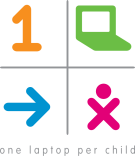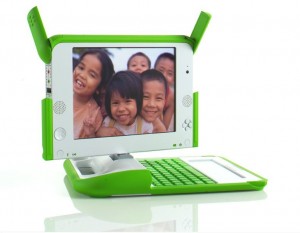As the month of May comes to a close and we wrap up our series of posts on ideas surrounding charity I wanted to look a little bit more into a story we looked at a few weeks ago during one of our Hexups. The article in question is about the One Laptop Per Child (OLPC) initiative and how they gave the children in an Ethiopian village some unopened boxes of tablets in order to see what they did with them. The article was entitled “Ethiopian Kids Hack OLPCs in 5 Months With Zero Instruction” and can be found over at www.dvice.com. Specifically I want to talk about how OLPC as a charity works to empower the children it helps and how I think this kind of charity could potentially offer one the best to ways to help educate children in the developing world.
 So what did happen when OLPC left 1000 laptops in a village with no indication of how to use them? The results are nothing short of amazing. First off, the article notes the laptops themselves were in their original packaging. The kids had to open the boxes and turn figure out how to turn the things on. None of them would have seen anything like this before. This first step apparently took them about four minutes. It should be noted as well that all the software on the devices was in English, and that not only did the kids not speak any English, none of them were literate and many had probably never even seen a written word. Within a matter of months the kids had not only mastered the use of the devices but put had learned English as well. They even figured out how to turn on the camera that had been disabled before the devices were dropped off.
So what did happen when OLPC left 1000 laptops in a village with no indication of how to use them? The results are nothing short of amazing. First off, the article notes the laptops themselves were in their original packaging. The kids had to open the boxes and turn figure out how to turn the things on. None of them would have seen anything like this before. This first step apparently took them about four minutes. It should be noted as well that all the software on the devices was in English, and that not only did the kids not speak any English, none of them were literate and many had probably never even seen a written word. Within a matter of months the kids had not only mastered the use of the devices but put had learned English as well. They even figured out how to turn on the camera that had been disabled before the devices were dropped off.
Firstly, and mostly besides the point, this is just really cool. It says a lot about the curiosity and learning capabilities of human children. I can just imagine the sense of wonder and exploration each of this kids must have felt and they learned to do more and more with the tablets they had been given. I can picture them learning and teaching each other tricks each had found and maybe even excitedly trying to explain to the grownups. I was struck by this story the first time that I read it and when I included it in the Hexup for the week I knew I would want to talk a bit more about it. I was encouraged to read a little bit more about the OLPC and how they work.
One Laptop Per Child is a nonprofit that was started in Cambridge Massachusetts in 2005 with the goal of providing cheap durable laptops for children in developing nations. The laptops are designed to be rugged and inexpensive tools for learning and education. They are also designed with displays that can be used in direct sunlight for areas where schools are outdoors. They are connected to the internet and have very low power requirements that make things like solar chargers possible. According the their website OLPC has distributed over 2.5 million of the laptops in Latin America and Africa. OLPC receives funding from all kinds of sources including large corporations who have helped developed the hardware and the software as well as through private donations.
The thing that I like about the OLPC approach is that they focus on empowerment of the children involved. The project, and the tablet example from Ethiopia, are designed to let children take control of the means of their own education and development. OLPC does this by making sure that the computers are owned by the children. They get to take them home and care for the machines themselves. The laptops are also connected to the internet and use open source software so that they can be upgraded and adapted to a child’s needs. They also take measures to make sure that the devices are provided in a large enough quantity so that an entire village or school will get one, so no child gets left behind.
There have been some criticisms of the project one of which is the cost of the devices. Originally planned to be about $100 the laptops are still slightly over $200. This doesn’t seem like much to us, but in many places around the world people survive on as little as $365 a year and this makes the laptop a significant investment. Other critics wonder if perhaps the money could be better spent providing basic needs like food, running water, or shelter and that the focus on western technology ignores the needs of the nations receiving the devices. There also seems to be some evidence that while strong to begin with, usage drops off sharply with time if there aren’t teachers and classrooms specifically geared toward using the computers. There are also concerns about the environmental impact of some of the components that are commonly found in computers.
I must admit that when I first came across the article I didn’t immediately think of any of these criticisms and was instead caught up in the beauty of the idea. I am of course looking at it from a Western point of view, and cheap technology for everyone is often seen as a Western ideal. Even after writing this blog post and giving it a lot of thought, I still find the OLPC project fascinating. Partially it’s because it fits in with what I have talked about in previous posts this month: I like it when charity gives the recipient the chance to help themselves. I also think that there are children out there that if given this kind of educational freedom would leap at the opportunity. I can only wonder at what I would have done if given a laptop as a child. I think that while serious, none of the criticisms break the idea and with some work could be resolved. The prices, like in all electronics will continue to lower, OLPC has already made using environmentally friendly electronics a priority (as much as possible) and technology and education can only foster dialogue with teachers and communities in developing areas. Surely technological improvements can me made alongside infrastructural improvements. We also have to think of the potential learning opportunities for the children. As the people over at OLPC say, don’t think of it as giving a child a laptop but as giving them an education.
D.
